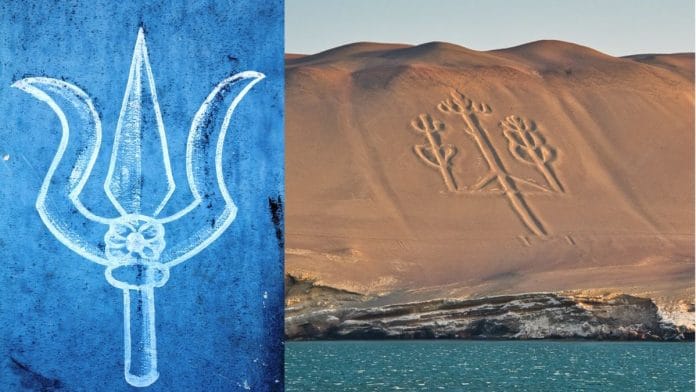Thank you dear subscribers, we are overwhelmed with your response.
Your Turn is a unique section from ThePrint featuring points of view from its subscribers. If you are a subscriber, have a point of view, please send it to us. If not, do subscribe here: https://theprint.in/subscribe/
Trishul and South America: A Cultural and Mythological Connection
Exploring the intricate tapestry of human history often reveals surprising connections between seemingly disparate cultures. One such intriguing link is the potential connection between the Trishul, an ancient Hindu symbol, and South American cultures. This essay delves into the linguistic, cultural, genetic, and geological threads that weave these distant regions together, drawing on the content of the Youtube video by Nilesh Oak in “Candelabra of Andes (त्रिशिराः काञ्चनः केतु), Valmiki Ramayana and Radiocarbon dating” and my added insights here.
The Trishul, or trident, is a powerful symbol in Hindu mythology, often associated with Lord Shiva. It represents various triads such as creation, maintenance, and destruction; past, present, and future; and the three gunas (qualities) of nature. The presence of a similar symbol in South America, particularly in the form of the Candelabra of the Andes, raises questions about the origins and spread of these symbols.
The Candelabra of the Andes, also known as the Paracas Candelabra, is a prehistoric geoglyph etched into the soil of the Paracas Peninsula in Peru. This geoglyph is approximately 600 feet tall and can be seen from as far as 12 miles out at sea. Its exact purpose and origin remain a mystery, but it is generally believed to date back to around 200 BCE, while Nilesh Oak has suggested it is actually 13th millenium BCE or 12209 BCE. Some theories suggest it may have served as a navigational guide for sailors, while others propose it had religious or ceremonial significance.
The resemblance between the Trishul and the Candelabra of the Andes, although not definitive proof, adds to the body of circumstantial evidence supporting the possibility of ancient trans-oceanic interactions.
The Dravidian languages, including Tamil and Telugu, have a rich history dating back thousands of years. These languages, primarily spoken in southern India, boast long literary traditions. Interestingly, some researchers have noted similarities between the Dravidian languages and certain indigenous languages of South America. For example, structural and phonetic resemblances between Tamil and the Quechua language of the Andes have sparked debates among linguists about possible ancient connections.
Cultural parallels also abound. The architectural styles of ancient South Indian temples and the pyramids of Mesoamerica share striking similarities. Both regions exhibit a penchant for intricate stone carvings and monumental structures that align with celestial bodies. The motifs and symbols found in South Indian art, such as the serpent and the lotus, also appear in the iconography of pre-Columbian civilizations like the Maya and the Aztecs.
The genetic history of the indigenous peoples of the Americas is complex and multifaceted. Genetic analysis has identified a specific genetic signature, known as the “Y signal,” linking some South American tribes to populations in South Asia, including India. This genetic marker, found in both ancient and modern indigenous people in the Amazon, indicates a shared ancestry with groups from South Asia, Australia, and Melanesia. The presence of this marker supports the theory of ancient maritime migrations connecting these distant regions.
Recent geological studies have unveiled fascinating insights into the ancient connections between Andhra Pradesh and various continents, including South America, Africa, Australia, and Antarctica. Scientists from the National Geophysical Research Institute (NGRI) in Hyderabad discovered evidence of a historic collision between the Indian subcontinent and East Antarctica over a billion years ago, leaving significant geological features such as a hidden ridge beneath the Darsi and Addanki regions of Andhra Pradesh. The geological formations in Andhra Pradesh, particularly the Cuddapah basin, provide crucial evidence of these ancient connections.
Adding another layer to this intricate web of connections is the linguistic overlap between Quechua and Sanskrit. Scholars have identified several words in Quechua that bear striking similarities to Sanskrit terms. For example, the Quechua word “santiya,” meaning “to rest,” is derived from the Sanskrit word “shanti,” which means “peace.” Such linguistic parallels suggest a deeper historical connection and possible cultural exchanges between these ancient civilizations.
In conclusion, the resemblance between the Trishul and the Candelabra of the Andes, along with the consideration of ancient maritime capabilities, linguistic similarities, and genetic markers, provides a compelling case for exploring potential cultural and mythological connections between ancient India and South America. The geological and genetic evidence together paint a picture of a world where ancient civilizations were far more interconnected than previously thought. This interconnectedness challenges our conventional understanding of human history and underscores the importance of interdisciplinary research in uncovering the complexities of our past.


